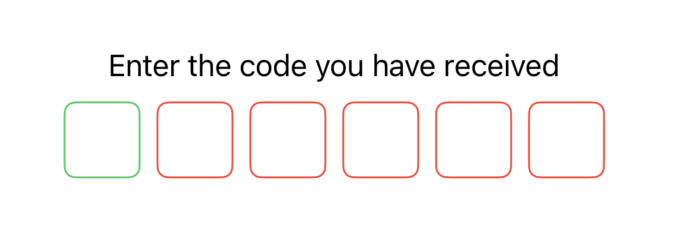In an earlier post https://seald-apps.com/how-to-build-a-phone-number-control-swiftui/ we have build a phone number control which can be used to capture a user’s phone number as part of an authentication flow. After this your server can send a verification code (a.k.a pincode) via a text message to the user.
Now we need a nice way to allow the user to enter this code, which is what we are gonna build in this post.
Our ContentView
Our contentView is pretty simple, we declare a @State variable for the pincode and we display the PincodeVerificationView(). We also need a way to know when all the digits are entered and for that we have implemented the .onReceive function for a notification in which we parse the pincode from the userInfo object.
import SwiftUI
struct ContentView: View {
@State var pincode:String = ""
var body: some View {
VStack {
Text("Enter the code you have received")
PincodeVerificationView()
}
.onReceive(NotificationCenter.default.publisher(for: Notification.Name.init("pincodeEntered"))) { obj in
self.pincode = obj.userInfo!["pincode"] as! String
//do you validation if the code is correct
}
.padding()
}
}
The PincodeVerificationView
Below you will find the full code, which is pretty much self explanatory. We have defined a length of 6 meaning the pincode will consists of 6 digits and we will render 6 input fields.
For each instance we call the @ViewBuilder function OTPTextBox to render it. The entered digit will display as a * and we use the background modifier to set a stroke color.
We are using the onChange(of: otpText) to determine is have have our six digits and when we do, we post a notification and pass the entered code in the userInfo so the receiver in the ContentView can validate it.
import Foundation
import SwiftUI
struct PincodeVerificationView: View {
@State private var otpText = ""
@FocusState private var isKeyboardShowing: Bool
let length = 6
var body: some View {
VStack {
HStack(spacing: 10){
Spacer()
ForEach(0..<length, id: \.self) { index in
OTPTextBox(index)
}
Spacer()
}
.background(content: {
TextField("", text: $otpText)
.keyboardType(.numberPad)
.textContentType(.oneTimeCode)
.frame(width: 1, height: 1)
.opacity(0.001)
.blendMode(.screen)
.focused($isKeyboardShowing)
.onChange(of: otpText) { newValue in
if newValue.count == length {
let data = ["pincode" : otpText]
NotificationCenter.default.post(name: Notification.Name.init("pincodeEntered"), object: nil, userInfo:data)
}
}
.onAppear {
DispatchQueue.main.async {
isKeyboardShowing = true
}
}
})
.contentShape(Rectangle())
.onTapGesture {
isKeyboardShowing = true
}
Spacer()
}
}
@ViewBuilder
func OTPTextBox(_ index: Int) -> some View {
ZStack{
if otpText.count > index {
let startIndex = otpText.startIndex
let charIndex = otpText.index(startIndex, offsetBy: index)
let charToString = String(otpText[charIndex])
Text("*")
} else {
Text(" ")
}
}
.frame(width: 42, height: 42)
.background {
let status = (isKeyboardShowing && otpText.count == index)
RoundedRectangle(cornerRadius: 6, style: .continuous)
.stroke(status ? Color.green : Color.red)
.animation(.easeInOut(duration: 0.2), value: status)
}
}
}
The complete project can be downloaded here https://github.com/arikivandeput/PincodeVerificationView.git


Comments are closed